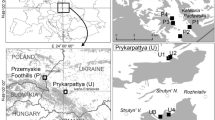Abstract
The ecological situation of oases at the southern border of the Taklamakan desert is shortly described, and the importance of a vegetation from indigenous species at the transition from the oases to the desert is emphasized. This vegetation serves as a shelter against sand drift and as a source of livestock feed as well as of fuel and construction material. Its destruction through overexploitation and other interventions during the last decades has considerably promoted sand drift and the deterioration of arable land. Therefore, a management of this protective vegetation is to be developped that leads to a sufficient regeneration and that ensures both its preservation and its use. A research project that is carried through jointly by Chinese and European scientists shall yield an ecological basis for this sustainable management.
Access this chapter
Tax calculation will be finalised at checkout
Purchases are for personal use only
Preview
Unable to display preview. Download preview PDF.
Similar content being viewed by others
References
Coque R, Gentelle P, Coque-Delhuille B (1991) Desertification along the piedmont of the Kunlun chain (Hetian—Yutian sector) and the southern border of the Taklamakan desert (China): preliminary geomorphological observations (1). Rev Géomorphol Dyn 40: 1–27
Devitt DA, Piorkowski JM Smith SD Cleverly JR, Sala A (1997) Plant water relations of Tamarix ramosissimain response to the imposition and alleviation of soil moisture stress. J. Arid Environ. 36: 527–540
Walter H, Box EO (1983) The deserts of Central Asia. In: West NE (ed) Ecosystems of the World 5: Temperate deserts and semi-deserts. Elsevier, pp 193–236
Xia X, Li C, Zhou X, Huang P, Pan B (1993) Desertification and control of blown sand disasters in Xinjiang. Science Press, Beijing, 298 pp
Yang X (1991) Geomorphologische Untersuchungen in Trockenräumen NW-Chinas unter besonderer Berücksichtigung von Badanjilin und Takelamagan. Göttinger Geographische Abhandlungen 96. Goltze, Göttingen, 124 pp
Zhang H (1995a) The comprehensive controlling and demonstrating study on the transition zone at the southern margin of Taklamakan desert. Arid Zone Res 12 (4): 1–9
Zhang H (1995b) Relations between soil moisture and natural vegetation around Cele oasis. Arid Zone Res 12 (4): 41–43
Editor information
Editors and Affiliations
Rights and permissions
Copyright information
© 2001 Springer-Verlag Berlin · Heidelberg
About this paper
Cite this paper
Runge, M. et al. (2001). Contributions to a Sustainable Management of the Indigenous Vegetation in the Foreland of Cele Oasis — A Project Report from the Taklamakan Desert. In: Breckle, SW., Veste, M., Wucherer, W. (eds) Sustainable Land Use in Deserts. Springer, Berlin, Heidelberg. https://doi.org/10.1007/978-3-642-59560-8_36
Download citation
DOI: https://doi.org/10.1007/978-3-642-59560-8_36
Publisher Name: Springer, Berlin, Heidelberg
Print ISBN: 978-3-642-64027-8
Online ISBN: 978-3-642-59560-8
eBook Packages: Springer Book Archive




